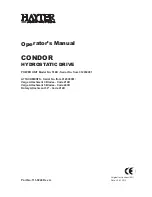
9 — English
ELECTRICAL
GENERATOR CAPACITY
Make sure the generator can supply enough continuous (run-
ning) and surge (starting) watts for the items you will power
at the same time. Follow these simple steps.
1. Select the items you will power at the same time.
2. Total the continuous (running) watts of these items. This
is the amount of power the generator must produce to
keep the items running. See the wattage reference chart
at right.
3. Estimate how many surge (starting) watts you will need.
Surge wattage is the short burst of power needed to
start electric motor-driven tools or appliances such as a
circular saw or refrigerator. Because not all motors start
at the same time, total surge watts can be estimated by
adding only the item(s) with the highest additional surge
watts to the total rated watts from step 2.
Example:
Tool or Appliance
Running
Watts*
Starting
Watts*
Quartz Work Light
(1000 Watt)
1000
0
Reciprocating Saw
960
960
Drill (1/2 inch,
5.4 amps)
600
900
Circular Saw (Heavy
Duty, 7-1/4 in.)
1400
2300
Demolition hammer
600
1200
4560 Total
Running Watts
2300 Highest
Starting Watts
Total Running Watts
4560
Highest Starting Watts + 2300
Total Starting Watts Needed
6860
Tool or Appliance
Estimated
Running
Watts*
Estimated
Starting
Watts*
DIY/Job Site
Quartz Work Light (1000 Watt)
1000
0
Circular Saw (Heavy Duty, 7
1/4”)
1400
2300
Drill (1/2 inch, 5.4 amps)
600
900
Miter Saw (10”)
1800
1800
Battery Charger (15 amp)
380
0
Reciprocating Saw
960
960
Air Compressor (1 HP)
1600
4500
Demolition hammer
1260
1260
Airless Sprayer (1/3 hp)
600
1200
Radio
200
0
Fan (20” Box Fan)
60
200
*Wattages listed are approximate. Check tool or equipment for actual wattage.
POWER MANAGEMENT
To prolong the life of the generator and attached devices,
it is important to take care when adding electrical loads to
the generator. There should be nothing connected to the
generator outlets before starting its engine. The correct and
safe way to manage generator power is to sequentially add
loads as follows:
1. With nothing connected to the generator, start the engine
as described later in this manual.
2. Plug in and turn on the first load, preferably the largest
load you have.
3. Permit the generator output to stabilize (engine runs
smoothly and attached device operates properly).
4. Plug in and turn on the next load.
5. Again, permit the generator to stabilize.
6. Repeat steps 4 and 5 for each additional load.
Never add more loads than the generator capacity. Take
special care to consider surge loads in generator capacity
as previously described.
NOTICE:
Do not overload the generator’s capacity.
Exceeding the generator’s wattage/amperage
capacity may damage the generator and/or
electrical devices connected to it.
Содержание RD906814P
Страница 69: ...NOTES NOTAS...
















































